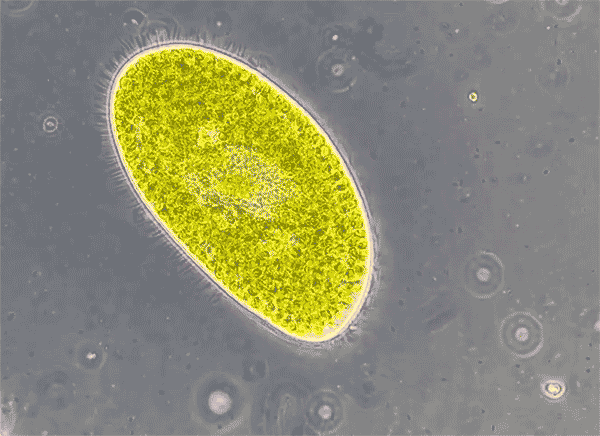A climate feedback loop that can expedite climate change has been determined by scientists studying a group of extensive but often neglected microbes. However, it is not all bad news: this one shows an early warning signal.
 A new modeling study suggests that warming temperatures may make many species of ocean plankton and other single-celled creatures like this Paramecium bursaria become a carbon source instead of a sink. This means that they could no longer be counted on to mitigate climate change. Before they reach this point, however, they give off an early warning signal: a period of fluctuating densities as they get closer to the brink. Image Credit: Duke University.
A new modeling study suggests that warming temperatures may make many species of ocean plankton and other single-celled creatures like this Paramecium bursaria become a carbon source instead of a sink. This means that they could no longer be counted on to mitigate climate change. Before they reach this point, however, they give off an early warning signal: a period of fluctuating densities as they get closer to the brink. Image Credit: Duke University.
With the help of a computer simulation, a research group from Duke University and the University of California, Santa Barbara, displayed that the majority of the world’s ocean plankton and several other single-celled creatures in peatlands, lakes, and other ecosystems could cross a threshold where rather than soaking up carbon dioxide, they begin to do the opposite. This is because warming impacts their metabolism.
Since carbon dioxide is a greenhouse gas that could increase temperatures further, a positive feedback loop could result in a runaway change, where small amounts of warming have an oversized effect.
However, by cautiously tracking the abundances of such organisms, one may be able to predict the tipping point before it gets here, the scientists report in a study published in the journal Functional Ecology on June 1st, 2023.
In the new study performed, scientists concentrated on a group of small organisms known as mixotrophs. Mixotrophs are named so as they mix up two modes of metabolism: they could hunt food like an animal or photosynthesize like a plant, based on conditions.
They’re like the Venus fly traps of the microbial world.”
Daniel Wieczynski, Study First Author and Postdoctoral Associate, Duke University
At the time of photosynthesis, they soak up carbon dioxide, a heat-trapping greenhouse gas. When they eat, they liberate carbon dioxide. Such adaptable organisms are not taken into account as the majority of models of global warming, yet they play a significant role in controlling climate, stated senior author Jean P. Gibert of Duke.
The majority of the plankton present in the ocean—things like diatoms, and dinoflagellates—are mixotrophs. Also, they are common in peatlands, lakes, damp soils, and beneath fallen leaves.
If you were to go to the nearest pond or lake and scoop a cup of water and put it under a microscope, you’d likely find thousands or even millions of mixotrophic microbes swimming around.”
Daniel Wieczynski, Study First Author and Postdoctoral Associate, Duke University
“Because mixotrophs can both capture and emit carbon dioxide, they're like ‘switches’ that could either help reduce climate change or make it worse,” stated co-author Holly Moeller, an Assistant Professor at the University of California, Santa Barbara.
The scientists came up with a mathematical model to forecast how mixotrophs may shift between various modes of metabolism as the climate continues to warm. This was done to comprehend how these impacts may scale up.
With the help of a 4-degree span of temperatures, from 19 to 23 °C (66–73 °F), the researchers ran their models. Global temperatures are probably to stream 1.5 °C above pre-industrial levels within the next five years and are on pace to reach 2 to 4° before the end of this century.
The examination displayed that the warmer it gets, the more mixotrophs depend on eating food instead of making their own via photosynthesis. As they perform, the balance between carbon in and carbon out has been shifted.
Ultimately, the models denote that one could see such microbes reach a tipping point—a threshold beyond which they abruptly flip from carbon sink to carbon source, thereby having a net warming effect rather than a cooling one.
This tipping point is hard to undo. As soon as they cross that threshold, it would take considerable cooling—over 1 ºC—for their cooling effects to be restored, the findings indicate.
The scientists stated, however, it is not all bad news. Also, their outcomes indicate that it might be feasible to spot such shifts in advance if one watches out for variations in mixotroph abundance over time.
Right before a tipping point, their abundances suddenly start to fluctuate wildly. If you went out in nature and you saw a sudden change from relatively steady abundances to rapid fluctuations, you would know it’s coming.”
Daniel Wieczynski, Study First Author and Postdoctoral Associate, Duke University
But if the early warning signal is detectable, it may rely on one more main factor disclosed by the study: nutrient pollution.
Discharge from wastewater treatment facilities and runoff from farms and lawns tied with chemical fertilizers and animal waste could send nutrients like phosphate and nitrate into streams, lakes and coastal waters.
When greater amounts of such nutrients in their models were included by Wieczynski and his collaborators, they found that the range of temperatures over which the telltale fluctuations happen begins to shrink until finally the signal disappears and the tipping point is reached with no obvious warning.
The model’s predictions still need to be confirmed with real-world observations, but they “highlight the value of investing in early detection,” stated Moeller.
Gibert stated, “Tipping points can be short-lived, and thus hard to catch. This paper provides us with a search image, something to look out for, and makes those tipping points—as fleeting as they may be—more likely to be found.”
Source:
Journal reference:
Wieczynski, D. J., et al. (2023) Mixotrophic microbes create carbon tipping points under warming. Functional Ecology. https://besjournals.onlinelibrary.wiley.com/doi/full/10.1111/1365-2435.14350